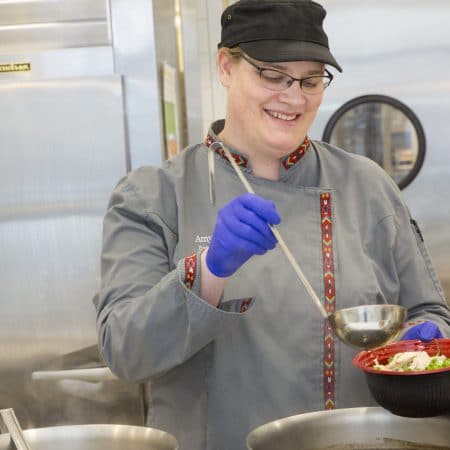To serve subsistence foods at the Alaska Native Tribal Health Consortium Medical Campus, Executive Chef Amy Foote has become an expert in federal, state and municipal food codes, hunting laws and guidelines. Photo by Chris Arend.
Where did you grow up?
I grew up in Boise, Idaho. I grew up fishing and foraging and hauling wood. After I met my husband, I learned how to hunt and butcher the wild game. I do all my own butchering, smoking, curing and pickling. A lot of what I learned was just by watching and listening to Elders. That’s how I learn from our staff, when they share their traditional knowledge.
What was your first job?
My first job was seasonal, helping in the kitchen and hauling freight at a wilderness camp on Growler Island in Prince William Sound (for Stan Stephens Cruises and CIRI). That’s where I fell in love with Alaska. I spent six summers in the sound, while I finished my schooling.
Where did you study or train?
I have an associate’s degree in culinary arts from Boise State University. I’m a certified dietary manager (an expert in food service management and food safety) and a certified healthcare environmental services professional (trained in operations, administration and compliance, with years of management experience in a healthcare setting).
For 10 years, before moving up to Alaska, I was the director of food services and environmental services at the North Valley Hospital in Whitefish, Montana.
What is your current job?
I’m the area executive chef at the ANTHC Medical Campus. (Alaska Native Tribal Health Consortium provides health services to Alaska Native and American Indian people in Alaska. ANTHC operates the Alaska Native Medical Center, ANMC.) I started in December of 2014.
I feel honored to have this job. ANMC is unique. It’s a place of healing, but it’s also a living art museum, a gathering place, and a cultural community center. On a good day, there might be 5,000 people on campus.
What do you like best about what you do?
Our job is to heal people. We’re here to comfort them and nourish them back to health. They may be in pain. They’re vulnerable. They may have fear. Most have come a long way; some by boat, snow machine, small planes, through airports and cold places. Once they get here, they still have to go through processing: admittance, records—all in a new language (medical terminology), new words and acronyms. After all that, food plays an important role in bringing them comfort. Food is medicine.
Tell us about your menu.
We create our menus using about 60 percent traditional ingredients. Our patients come from all over the state, from different climates, with different palates. Traditional food is familiar. It brings home to them.
On Tuesdays, in collaboration with the ANTHC Culture Committee, we serve seal soup to those patients who can have it. We call it “Traditional Tuesday.”
We continue to expand traditional foods on our menu. Items include salmon lox and smoked salmon, reindeer stew and reindeer pot pie, fry bread and Eskimo ice cream (akutaq). We’ve tried different versions of akutaq—with and without sheefish, and with Greek yogurt.
We fuse traditional ingredients with “town” food, like fiddlehead fern pizza and “chagamisu,” which is like tiramisu (the Italian dessert) but made with chaga (a mushroom-like fungus that grows on birch trees and is full of antioxidants).
Modern guidelines meet traditional ways in the food we prepare.
Where do you source the traditional foods?
We only serve wild-caught Alaskan salmon. We purchase some from Indian Valley, 10 & M Seafoods and Tustamena Smokehouse.
We also receive donations of fish, seafood and wild game meat (moose, deer and caribou), marine mammal meat (maktak and seal meat), wild berries and plants (including fiddlehead ferns and sour dock).
I firmly believe that if you run the program, you should walk the talk and donate too. I personally harvest (and donate) dandelions, berries, tundra tea, rosehips and spruce tips. My husband has donated some of our moose and bones.
Proof of the donation program’s success is we now have three freezers. We have a structured intake policy. Food we can’t use is not wasted; it’s donated to the Alaska Zoo. (Here’s how to donate: http://anmc.org/files/Traditional_Foods_Poster.pdf.)
Who or what inspires you?
Nature and its beauty inspire me. A culture of living off the land inspires me. That was how I was raised.
The people I’m privileged to serve inspire me. Watching our patients heal by the power of traditional foods inspires me to tell our story, promote our program and develop relationships with hunters and gatherers throughout the state.
The people I work with inspire me. One of them is Ralph Barger (a NANA shareholder from Noatak). We had a fry bread cook-off and he won. You could taste the love in it.
What important lessons have you learned?
Honor and respect the work of those who came before you. Every day, I learn something new by listening and watching and sharing stories. I’ve learned to try everything once; you’ll never know what can happen when you just try. It’s life-changing.
Traditional foods contain healing properties. As much as possible, I practice traditional medicine and make my own teas, tincture, soaps, compress and salves.
This is who I am. This is how I was raised.
***
Amy Foote was interviewed by Carol Richards, Director of Brand Communications for NANA.



